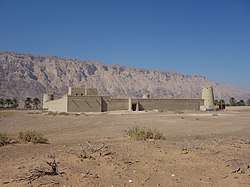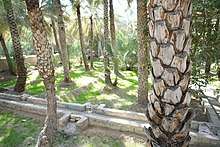Tawam (region)
Tawam (Arabic: تَوَام, romanized: Tawām),[5] also Tuwwam,[2][3] Tu'am, or "Al-Buraimi Oasis" (Arabic: وَاحَة ٱلْبُرَيْمِي, romanized: Wāḥat Al-Buraymī),[4][6] is a historical oasis region in Eastern Arabia that stretched from, or was located between, the Western Hajar Mountains to the Arabian or Persian Gulf coast, nowadays forming parts of what is now the United Arab Emirates and western Oman. It is marked by the twin settlements of Al Ain and Al-Buraimi on the UAE-Omani border.[1]
Tawam[1] | |
|---|---|
 Mezyad Fort in Al Ain (UAE), with Jebel Hafeet, which is partially in the Omani Governorate of Al-Buraimi, in the background | |
| Boroughs | Al-Ain ( Al-Buraimi ( |
Etymology and geography

Al-Ain is main settlement[7][8] in the Eastern Region of the Emirate of Abu Dhabi, located on the country's eastern border with Oman, where the adjacent town of Al-Buraimi is located. The region is located to the west of the Western Hajar Mountains[9] and the Gulf of Oman,[1] and in the vicinity of the Rub' al-Khali Desert.[3] On the coast of the Arabian or Persian Gulf lies Jumayra in the Emirate of Dubai, which was probably part of this region.[5][10]
The word 'Tawam' means 'twins', and it reportedly refers to a pair of alfaj (water channels) in the Buraimi region, as identified from the works of people like Salil ibn Raziq in the 19th century, Al-Tabari and Al-Muqaddasi[3] in the 10th century, and consequently people in the 21st century like Timothy Power, an archaeologist and assistant-professor based in Abu Dhabi who helped to found the Buraimi Oasis Landscape Archaeology Project. That said, the region is composed of oases which depended on aflaj for irrigation,[9] such as those of Al-Ain and Qattarah in Al-Ain, and Hamasa in Al-Buraimi.[5]
In the mid-19th century, an Omani scholar, Salil ibn Raziq, basically said that Buraimi used to be called Tawam. People picked up on that but have never critically examined the earlier sources. Al Tabari writes of a Persian sphere of influence along the Batinah plain of Oman and an Arab sphere of influence in the interior with its capital at a place called Tawam. In that he deals with the events of 893/94, in which there is a dispute amongst different local factions about who should rule in Oman. One of these factions approaches the Abbasids for outside assistance. The faction who do this are called the Bani Sama and they are based in Buraimi before they base themselves in Sohar, call themselves the Wajihid Dynasty and assume the leadership of the whole region.
— Timothy Power.[5]
Hafit {Tuwwam} abounds in palm trees; it lies in the direction of Hajar {Al Hasa}, and the mosque is in the markets ... Dibba and Julfar, both in the direction of the Hajar, are close to the sea ... Tuwwam has been dominated by a branch of the Quraysh ...
History and prehistory
Archaeological remains dating to the Bronze Age and beyond, like at Al-Rumailah, Hili and Jebel Hafeet,[11][12] have been found in this region. In ancient times, the region was reportedly used by Arabs as a place of gathering,[4][5] and like Dibba, it was taxed by Al-Julanda, who were clients of the Sasanians, who reported to the Persian marzban (military governor), who was based at Al-Rustaq in what is now Oman.[10]
Like Dibba and present-day Ras Al Khaimah, the region witnessed events relevant to the history of Islam during the Rashidun, Umayyad and Abbasid eras.[3][10]
Around the Islamic Golden Age in the Middle Ages, the region, with its capital at 'Tawam', was an important sphere of influence for Arabs. Ceramics and other materials found here were believed to have been imported from Mesopotamia, India and China. At this time, Sohar, located to the east of this region, was of such prominence as a trading port on the coast of the Gulf of Oman that it was considered to be the "Dubai or Singapore of its day". A mosque, considered to be the oldest in the country, was found in the vicinity of the Sheikh Khalifa Mosque in Al-Ain by Dr Walid Al Tikriti, besides a falaj, a group of houses, and a village dating to the 9th or 10th century.[5]
Being strategically located near the Western Hajar, the area was an important stop for people and caravans traveling between the mountains and other parts of Arabia, such as Al-Hasa. Not only was the area, being rich in date palms, important for trade, but it was also used by certain people for smuggling slaves, women or children, years before the foundation of the UAE.[9]
References
- Janet L. Abu-Lughod (contributor) (2007). "Buraimi and Al-Ain". In Dumper, Michael R. T.; Stanley, Bruce E. (eds.). Cities of the Middle East and North Africa: A Historical Encyclopedia. ABC-CLIO. pp. 99–100. ISBN 978-1-5760-7919-5.
- Al-Hosani, Hamad Ali (2012). The Political Thought of Zayed bin Sultan Al Nahyan (PhD Thesis) (Thesis). Durham University. pp. 43–44. Archived (PDF) from the original on 5 February 2017. Retrieved 15 April 2016.
- Morton, Michael Quentin (15 April 2016). Keepers of the Golden Shore: A History of the United Arab Emirates (1st ed.). London: Reaktion Books. ISBN 978-1-7802-3580-6. Retrieved 8 November 2016.
- Allen, Calvin H., Jr. (2016-02-05). "1: Land and People". Oman: the Modernization of the Sultanate. Abingdon, New York: Routledge. pp. 1–8. ISBN 978-1-3172-9164-0.
- Leech, Nick (2015-10-22). "The long read: has a lost Arab capital been found on the Oman-UAE border?". The National. Retrieved 2019-01-20.
- El Reyes, Dr. Abdulla, ed. (December 2014). Liwa Journal of the National Archives (PDF). United Arab Emirates: Emirati National Archives. pp. 35–37. Retrieved 5 February 2017.
- "Al Ain". The Report Abu Dhabi 2010. Oxford Business Group. 2010. pp. 171–176. ISBN 978-1-9070-6521-7.
- The Report Abu Dhabi 2016. Oxford Business Group. 2016-05-09. pp. 14–16. ISBN 978-1-9100-6858-8.
- Lancaster, Fidelity; Lancaster, William (2011). Honour is in Contentment: Life Before Oil in Ras Al-Khaimah (UAE) and Some Neighbouring Regions. Berlin, New York: Walter de Gruyter. pp. 130–324. ISBN 978-3-1102-2339-2.
- Abed, Ibrahim; Hellyer, Peter (2001). The United Arab Emirates, A New Perspective. London: Trident Press Ltd. pp. 60–86. ISBN 978-1-900724-47-0.
- Salama, Samir (2011-12-30). "Al Ain bears evidence of a culture's ability to adapt". Gulf News. Retrieved 2018-08-07.
- Potts, Daniel T.; Nābūdah, Ḥasan Muḥammad; Hellyer, Peter (2003). Archaeology of the United Arab Emirates. London: Trident Press. pp. 174–177. ISBN 1-9007-2488-X. OCLC 54405078.